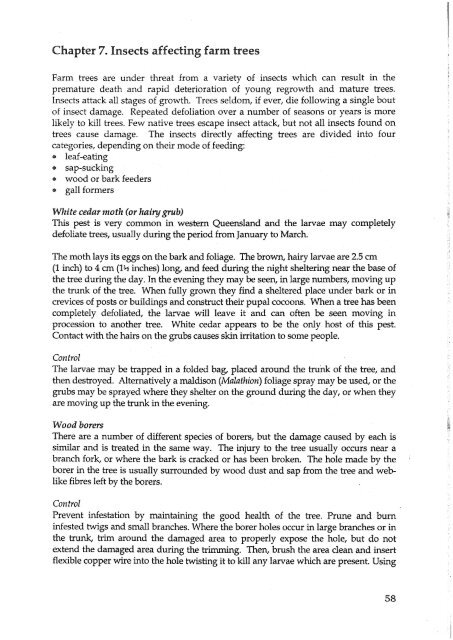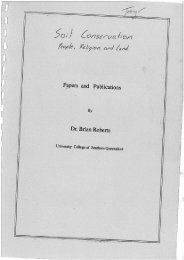western-queensland-gardening-guide.pdf - South West NRM
western-queensland-gardening-guide.pdf - South West NRM
western-queensland-gardening-guide.pdf - South West NRM
Create successful ePaper yourself
Turn your PDF publications into a flip-book with our unique Google optimized e-Paper software.
Chapter 7. Insects affecting farm trees<br />
Farm trees are under threat from a variety of insects which can result in the<br />
premature death and rapid deterioration of young regrowth and mature trees.<br />
Insects attack all stages of growth. Trees seldom, if ever, die following a single bout<br />
of insect damage. Repeated defoliation over a number of seasons or years is more<br />
likely to kill trees. Few native trees escape insect attack, but not all insects found on<br />
trees cause damage. The insects directly affecting trees are divided into four<br />
categories, depending on their mode of feeding:<br />
leaf-eating<br />
sap-sucking<br />
wood or bark feeders<br />
gall formers<br />
White cedar moth (or hairy grub)<br />
This pest is very common in <strong>western</strong> Queensland and the larvae may completely<br />
defoliate trees, usually during the period from January to March.<br />
The moth lays its eggs on the bark and foliage. The brown, hairy larvae are 2.5 cm<br />
(1 inch) to 4 cm (1% inches) long, and feed during the night sheltering near the base of<br />
the tree during the day. Jn the evening they may be seen, in large numbers, moving up<br />
the trunk of the tree. en fully grown they find a sheltered place under bark or in<br />
crevices of posts or buildings and construct their pupal cocoons.<br />
completely defoliated, the 1 will leave it and can often be seen moving in<br />
procession to another tree. e cedar appears to be the only host of this pest.<br />
Contact with the hairs on the grubs causes skin irritation to some people.<br />
Control<br />
The larvae may be trapped in a folded bag, placed around the tru'nk of the tree, and<br />
then destroyed. Alternatively a maldison (Malathion) foliage spray may be used, or the<br />
grubs may be sprayed where they shelter on the ground during the day, or when they<br />
are moving up the trunk in the evening.<br />
Wood borers<br />
There are a number of different species of borers, but the damage caused by each is<br />
similar and is treated in the same way. The injury to the tree usually occurs near a<br />
branch fork, or where the bark is cracked or has been broken. The hole made by the<br />
borer in the tree is usually surrounded by wood dust and sap from the tree and weblike<br />
fibres left by the borers.<br />
Control<br />
Prevent infestation by maintaining the good health of the tree. Prune and burn<br />
infested twigs and small branches. Where the borer holes occur in large branches or in<br />
the trunk, trim around the damaged area to properly expose the hole, but do not<br />
extend the damaged area during the trimming. Then, brush the area clean and insert<br />
flexible copper wire into the hole twisting it to kill any larvae which are present. Using
















